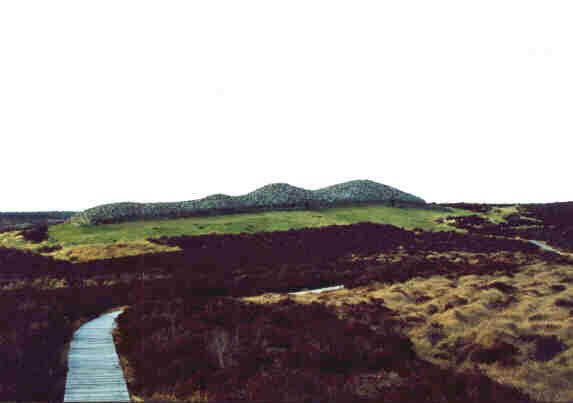|
Monuments and Water: |
| The
Grey Cairns of Camster The Camster cairns are probably the best known of all the Neolithic sites in Caithness. Camster Round was initially explored in the 1850’s and 1860’s, and its chamber was found to be virtually intact (Davidson & Henshall 1989). After further excavation and consolidation in the 20th century, it remains one of the best preserved Neolithic chambered cairns in northern Scotland. It was found to contain a large amount of human bone, together with animal bone and flint. There was also evidence of burning in the centre of the chamber, where quantities of charcoal and ash were particularly abundant (Davidson & Henshall 1989). The excavations of its neighbour, Camster Long by Anderson in 1866, and Corcoran and Masters in the 1970’s (Davidson & Henshall 1989) revealed a complex monument, with several apparent phases of construction (Masters 1997). Two chambers were located at the northern end of the cairn, each seemingly enclosed within an initial round cairn structure. The northern chamber was of a simple polygonal form, with a short passage, orientated SE, while the southern chamber was a more complex tripartite structure with a passage orientated almost due east (Masters 1997). It has been suggested that these would have stood as independent structures, before their consolidation within the later long cairn (Ashmore 1996). The simpler polygonal chamber would probably have been the primary construction on the site, followed by the more complex tripartite chamber (Masters 1997), possibly contemporary with the construction of the tripartite chamber and cairn of Camster Round. The evidence is not conclusive, however, and it has also been suggested that the monument is of single-phase construction (Masters 1997), with the circular revetments included as “constructional devices to support the chamber construction” (Masters 1997, 178). On investigation, both chambers were found to contain very little; a few fragments of bone and a sherd of pottery in the northern, polygonal chamber, and a compacted floor containing a small amount of ash and bone in the southern chamber (Davidson & Henshall 1991). |
|
Plate 3 – Camster Long
cairn |
| Of particular interest to the excavators was the discovery of evidence for pre-cairn activity beneath the southern end of the long cairn (Masters 1997). This consisted of a number of burnt areas, varying in size and on the same axis as the later cairn. Dates from the charcoal indicate that this activity occurred in the early centuries of the 4th Millennium BC (4950+/-80 BP, Masters 1997). Finds of pottery and flint debris associated with this burning activity may indicate that early Neolithic communities were using the site for temporary occupation and the manufacture of stone tools (Masters 1997, Wickham-Jones 1997). |
|
Back to Monumentality in Caithness Forward to The Camster Landscape |
